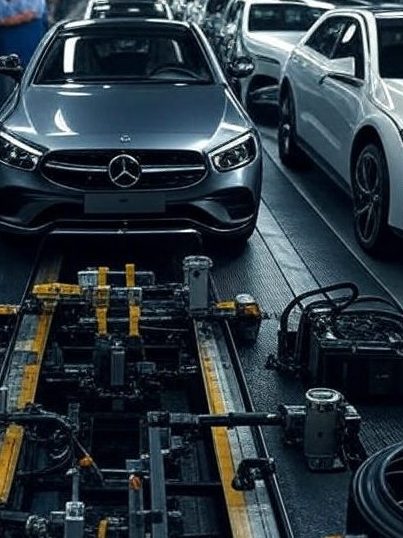
The Unseen Backbone of Modern Vehicles
The automotive industry, a global titan driving economies and innovation, finds itself teetering on the brink of a crisis in 2025. At the heart of this turmoil lies a critical shortage of rare earth magnets, the unsung heroes powering the electric vehicles (EVs), hybrids, and even traditional internal combustion engine (ICE) cars that dominate our roads. These magnets, crafted from rare earth elements like neodymium, dysprosium, and terbium, are the lifeblood of modern automotive technology. Their unique magnetic properties enable the high-efficiency motors, sensors, and steering systems that define contemporary vehicles.
Rare earth magnets are not just components; they are the keystones of a technological revolution. In EVs, permanent magnet synchronous motors (PMSMs) rely on these magnets to deliver exceptional torque and energy efficiency, making them indispensable for the shift toward electrification. Hybrids use them to blend gasoline and electric power seamlessly, while ICE vehicles depend on them for electric power steering and advanced sensors.
The Catalyst: China’s Export Stranglehold
The root of this crisis traces back to China, the undisputed colossus of rare earth production. Commanding over 70% of global mining, 85% of refining capacity, and nearly 90% of magnet manufacturing, China holds the automotive world in a vice-like grip. In April 2025, Beijing tightened export controls, This move, widely interpreted as retaliation to U.S. President Donald Trump’s tariff hikes, has sent shockwaves through global supply chains. Export volumes plummeted by half in April, with permit approvals bogged down by bureaucratic red tape, leaving manufacturers scrambling.
China’s dominance did not emerge overnight. Since the 1980s, the country capitalized on lax environmental regulations and state-backed investment to build a rare earth empire.
The Ripple Effect: A Global Production Paralysis
The ramifications of this magnet shortage are already reverberating across continents. In Europe, the European Association of Automotive Suppliers (CLEPA) reports that several plants have suspended operations, with more shutdowns looming as stockpiles dwindle. Mercedes-Benz and BMW, despite deploying buffers and magnet-free motor prototypes, face disruptions in their supplier networks.
The shortage’s impact transcends EVs. Rare earth magnets power a myriad of components—windshield wipers, seatbelt sensors, . A single missing magnet can stall an entire production line, a lesson learned during the chip crisis when automakers parked incomplete cars in lots, awaiting parts. Now, with magnet inventories projected to last only two to three months in some regions, the industry braces for a repeat scenario. The financial toll could be staggering, with potential losses mirroring the $210 billion hit U.S. automakers endured during the semiconductor debacle.
Economic and Strategic Implications
Beyond production, the crisis carries profound economic and strategic weight. Rare earth magnets, though accounting for less than 5% of a vehicle’s cost, are a linchpin for profitability. Rising prices—up 30% in some markets—threaten to inflate EV prices, potentially slowing consumer adoption at a time when governments push for carbon neutrality. In India, where the auto sector contributes 7.1% to GDP, a prolonged shortage could derail the $117.78 billion EV market projection by 2032. Globally, the automotive aftermarket, forecasted to reach $664 billion by 2028, faces supply constraints that could disrupt spare parts availability.
Strategically, China’s export curbs highlight a geopolitical chess game. Analysts see this as a calculated move to leverage rare earths in trade negotiations, a tactic used before during the 2010 Japan dispute. The U.S., reliant on China for 90% of its magnet needs, is accelerating domestic projects like the Mountain Pass mine and NioCorp’s Nebraska facility, but these won’t scale until 2027-2028. Europe and India are exploring alternatives in Australia, Vietnam, and Japan, yet refining capacity lags far behind demand. This dependency underscores a broader vulnerability, with China controlling over 50% of 19 key raw materials, from manganese to graphite, per a 2024 European Commission report.
Industry Responses: Innovation Under Pressure
Automakers are not passive victims; they are fighting back with a mix of innovation and diversification. Some, like BMW and Renault, are piloting magnet-free motors—induction or switched reluctance designs—that reduce rare earth reliance, though at the cost of efficiency. Research into iron-nitride magnets, using abundant materials, promises a long-term solution, but commercialization remains five to ten years away. Recycling efforts, led by companies like Redwood Materials, are gaining traction, recovering neodymium from old batteries and electronics, though current yields are a fraction of demand.
The Human Cost: Jobs and Communities at Risk
The crisis extends beyond balance sheets to human lives. The auto industry employs millions globally, with India’s EV sector poised to create 10 million jobs by 2030. A production halt could jeopardize these opportunities, hitting workers in manufacturing hubs like Detroit, Stuttgart, and Chennai. Small suppliers, lacking the resources to weather shortages, face bankruptcy, rippling through local economies. In India, where SLTL laser cutting tech supports EV component production, a magnet scarcity could idle high-skill jobs, stalling the “Make in India” momentum.
Communities reliant on auto plants—whether rural towns in the U.S. Midwest or industrial zones in Gujarat—could see economic downturns. The 2021-2023 chip shortage cut 100,000 passenger vehicles from Indian production, a 4% drop that echoed through dealerships and service centers. A magnet crisis could amplify this, with experts warning of shutdowns by July or August 2025 if supplies don’t flow.
The Path Forward: Diplomacy and Resilience
Diplomacy offers a short-term lifeline. U.S.-China trade talks in London and India’s delegation to Beijing aim to expedite export licenses, with some optimism following Trump’s claim that Xi Jinping agreed to resume supplies. However, experts caution that temporary fixes won’t address structural vulnerabilities. A stable resolution requires international cooperation, perhaps through a global rare earth alliance, to diversify production and enforce transparent trade norms.
Resilience hinges on long-term strategies. Automakers must accelerate R&D into alternative technologies, governments must incentivize domestic mining and refining, and industries must build resilient supply chains. The current crisis, while daunting, could catalyze a shift toward self-reliance, reducing the world’s reliance on a single supplier. As the industry navigates this storm, the lessons learned—about diversification, innovation, and geopolitical risks—will shape the automotive landscape for decades.
Conclusion: A Turning Point for the Auto Industry
The rare earth magnet shortage crisis of 2025 is more than a supply chain hiccup; it’s a pivotal moment for the auto industry. With production lines at risk, costs soaring, and jobs on the line, the stakes are immense. Yet, within this challenge lies opportunity—opportunity to innovate, to diversify, and to build a more sustainable future. As China’s export curbs test the industry’s mettle, the response will define whether the automotive world stalls or accelerates into a new era of resilience and independence. The road ahead is uncertain, but the drive for solutions is unstoppable.










